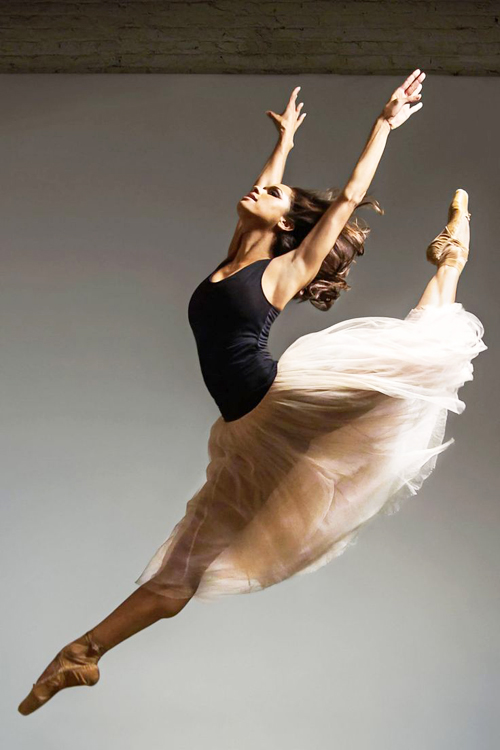Dance: Is Ballet Blanc for Whites Only?
By Dawn Lille
arttimesjournal March 13, 2018
Many ballet classics have silly or unbelievable stories - as do many operas - but some have an underlying concept like good versus evil. That cannot really be said of Don Quixote, which is not about Cervante’s great philosophical figure, but about the romance between Kitri and Basilio. It does have some firecracker sections of virtuosic dancing.
 Misty Copland |
American Ballet Theatre’s version, staged by Kevin McKenzie and Susan Jones, is not particularly exciting. The real reason for going to this during the last spring season was to see Misty Copland starring as Kitri and to experience a packed, adoring house filled with young girls of all colors, who applauded every turn and balance Copland performed.
As the first African American dancer to be made a principle in ABT (2015), Copland has received a tremendous amount of attention. Why it took 14 years to promote her (she was initially brought into the transitional Studio Company by Gage Bush Englund and moved to the main company in 2001) was a widely discussed issue. Why more women of color have not been recognized by America’s leading ballet companies, including the New York City Ballet, is another. Europe has offered much more employment.
Copland is not the first contemporary classically trained black dancer. Currently, some companies, reacting to the publicity surrounding her, have formed “diversity committees,” supposedly to search for ballet dancers of color.
Virginia Johnson was a founder and one of the first ballerinas of Dance Theatre of Harlem (DTH), which Arthur Mitchell, the first black male principle in New York City Ballet (NYCB), formed in 1969. Recognized internationally, she is now the artistic director of the company. Some time ago she published an article titled “Does Dance Have A Color?”
In it she writes, “Years after … Mitchell made a difference, dancers of color are again applicants at the gates begging to be accepted in an art form that literally can’t see us and so will not let us in.”
Historically, ballet studios in most American cities, including Philadelphia whose black ballet studios produced several outstanding performers, were segregated, but there were still many dancers of color trained in ballet. Among these was Deborah Austin. She was accepted into the NYCB after training at the School of American Ballet, its feeder institution, but never featured.
DTH was not the first company to give black ballet dancers - especially women, who had a much harder time - an opportunity to practice their art. In fact, in 1996 the Dance Collection of the Library of Performing Arts at Lincoln Center held an exhibit called Classic Black. It looked at ballet dancers prior to Mitchell’s company. At the final performance of the 2016 season of DTH Johnson honored 50 black ballerinas. Among them were Raven Wilkinson, who danced with the Ballets Russes de Monte Carlo, and Delores Browne, who was featured in the New York Negro Ballet.
 Delores Browne |
Founded in New York in 1955, this company successfully toured Great Britain in 1957, but was forced to close due to the death of its sponsor. The New York Negro Ballet, which at times performed under other names, had some outstanding and well reviewed dancers from all over the country. Among them were Georgia Collins, Elizabeth Thompson, Yvonne McDowell and Cleo Quitman. The last appeared as a guest artist with ABT.
Although the lack of opportunity may be discouraging and result in fewer potential ballerinas of color, they do exist. But, like many who preceded them for over 60 years, they end up performing in other genres because ballet is closed to them.
Browne tends to roll her eyes at the diversity committees. She thinks that by forming such an entity a basically white organization feels it is remedying a situation, when actually they are merely stalling to perpetuate what exists. She points out that all they have to do is visit ballet studios all over America, beginning in New York, to find qualified black ballet dancers.
Two years ago Browne, who performed extensively and was a major teacher at the Ailey School and Philadanco, joined forces with Joan Myers Brown, head of Philadanco and a classically trained dancer herself. They established a yearly audition highlighting the talent of women of color in ballet. It takes place wherever the International Association of Blacks in Dance is meeting. Representatives from ballet companies and dance programs are invited and scholarships, apprenticeships and contracts are awarded.
Misty Copland is nearer the end of her career than the beginning. The American Ballet Blanc world is slow to change. In the often negative chaos of contemporary living it would be encouraging to see some positive action in the classical dance arena. And diversity committees are not the answer. It is time for action, not talk, to make American ballet represent American diversity.
dawnlille@aol.com
